Thyme And Lemon Bundt Cake
by Nigella. Featured in SIMPLY NIGELLAIntroduction
I love thyme and sprinkle it wantonly in my cooking, but I wanted a cake that relied on it as a leading ingredient, not merely as a decorative flourish. Besides, with a rosemary loaf cake under my belt, I had no doubt that it would work. And it does. Don’t be alarmed at the amount of thyme in the cake batter, as it doesn’t overwhelm. It charms.
I’ve specified buttermilk in the ingredients list, but you can use runny plain yogurt in its stead. Or, easier still, make your own buttermilk — my fallback position — by adding 1 tablespoon of lemon juice (since you will have lemons to hand for this recipe; otherwise you can use white wine vinegar or cider vinegar instead) to 250ml/1 cup semi-skimmed milk and letting it stand for 20 minutes before you need it, stirring before use.
Now, a cautionary word: even when the cake looks bronzed and ready, you need to make sure that it’s cooked through around the funnel. Otherwise, not only will it be the devil to unmould, but you will also find the cake disappointingly undercooked (however brown it looks on the surface) once you slice into it.
And please read the Additional Information section at the end of the recipe before proceeding.
I love thyme and sprinkle it wantonly in my cooking, but I wanted a cake that relied on it as a leading ingredient, not merely as a decorative flourish. Besides, with a rosemary loaf cake under my belt, I had no doubt that it would work. And it does. Don’t be alarmed at the amount of thyme in the cake batter, as it doesn’t overwhelm. It charms.
I’ve specified buttermilk in the ingredients list, but you can use runny plain yogurt in its stead. Or, easier still, make your own buttermilk — my fallback position — by adding 1 tablespoon of lemon juice (since you will have lemons to hand for this recipe; otherwise you can use white wine vinegar or cider vinegar instead) to 250ml/1 cup semi-skimmed milk and letting it stand for 20 minutes before you need it, stirring before use.
Now, a cautionary word: even when the cake looks bronzed and ready, you need to make sure that it’s cooked through around the funnel. Otherwise, not only will it be the devil to unmould, but you will also find the cake disappointingly undercooked (however brown it looks on the surface) once you slice into it.
And please read the Additional Information section at the end of the recipe before proceeding.
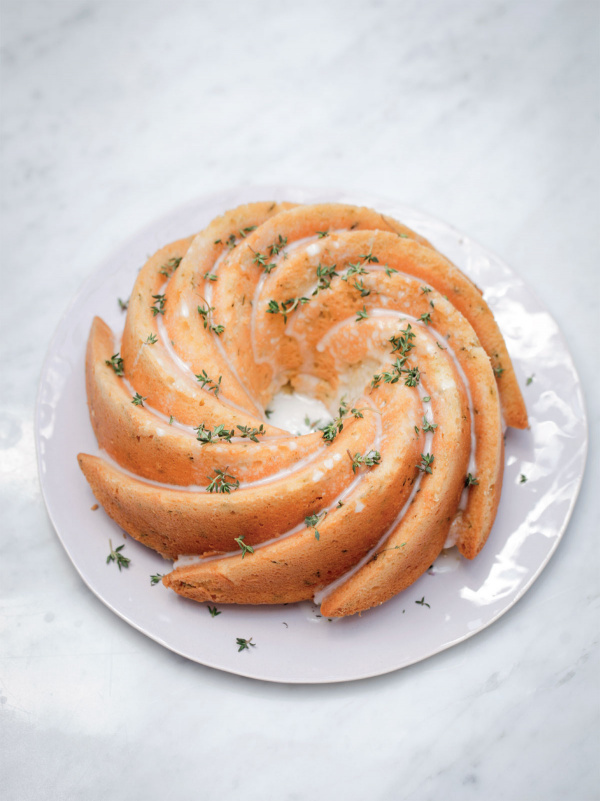
Share or save this
Ingredients
Yields: 10-14 slices
- 450 grams plain flour
- ¾ teaspoon baking powder
- ¾ teaspoon bicarbonate of soda
- 200 grams soft unsalted butter
- 2 unwaxed lemons
- small bunch fresh thyme
- 250 grams caster sugar
- 3 large eggs
- 250 millilitres buttermilk (see Intro)
- 120 grams icing sugar
- cooking spray (or sunflower oil and plain flour) for greasing
- 1 x 10-cup (2.5 litre capacity) bundt tin or 20cm/8 inch square cake tin approx. 5.5cm/2¼ inches deep
- 3 cups all-purpose flour
- ¾ teaspoon baking powder
- ¾ teaspoon baking soda
- 1 stick plus 5 tablespoons soft unsalted butter
- 2 unwaxed lemons
- small bunch fresh thyme
- 1¼ cups superfine sugar
- 3 large eggs
- 1 cup buttermilk (see Intro)
- 1¼ cups confectioners' sugar
- cooking spray (or sunflower oil and plain flour) for greasing
- 1 x 10-cup (2.5 litre capacity) bundt tin or 20cm/8 inch square cake tin approx. 5.5cm/2¼ inches deep
Method
- Preheat the oven to 170°C/325℉ gas mark 3, slipping in a baking sheet at the same time. Spray the inside of your bundt tin with non-stick cooking spray, or brush on a paste made of 2 teaspoons of plain flour mixed with 2 teaspoons of oil, making sure you get into all the crevices of the tin. Leave the bundt tin upside down over a piece of newspaper or baking parchment while you get on with making the cake batter. (And keep this piece of paper once you've put the batter in the tin, as it'll come in handy for the icing part.)
- Combine the flour, baking powder and bicarb in a bowl, and fork to mix.
- Put the butter in the bowl of a freestanding mixer or a regular mixing bowl, grate in the zest of both lemons and beat until creamy.
- Strip 4 tablespoons/¼ cup of thyme leaves from the sprigs, and add along with the caster sugar, and beat again until you have a light fluffy mixture.
- Now, one by one, beat in the eggs and, after the last one, slow down your mixing and add a third of the flour mixture, followed by a third of the buttermilk, and so on until both the flour mixture and buttermilk are used up.
- Finally, beat in the juice of 1 of the lemons and transfer this mixture to the prepared bundt tin. Place on the baking sheet in the oven and bake for 1¼ hours, though start checking after 1 hour. Don’t be alarmed if it looks like there’s too much batter for the bundt tin: all shall be well, and all manner of things shall be well. In other words, the cake will rise but then sink back down comfortably.
- When a cake tester comes out clean, remove the cake to a wire rack and leave in its tin for 15 minutes before carefully unmoulding. This is always a tense moment, but if the tin’s been sprayed or greased adequately, and the cake is fully baked, you should have no problem. Besides, it’s that moment of breathless tension which makes the dramatic unmoulding and unveiling all the more gratifying.
- When the cake is cool, slip the piece of newspaper or baking parchment under the wire rack, then sieve the icing sugar into a bowl and beat in the juice of the remaining lemon until you have a glaze that is thin enough to run down the cake – I reckon on 2½–3 tablespoons – but thick enough to act as a tangy glue for the thyme leaves you are about to sprinkle on top. Or you can pour this directly over the cake on its serving plate. Duly pour the sherbetty glaze over the cake, and immediately scatter with thyme leaves and the odd sprig or two. How many you add is entirely up to you, but I tend to strew with abandon.
- Preheat the oven to 170°C/325℉ gas mark 3, slipping in a baking sheet at the same time. Spray the inside of your bundt tin with non-stick cooking spray, or brush on a paste made of 2 teaspoons of all-purpose flour mixed with 2 teaspoons of oil, making sure you get into all the crevices of the tin. Leave the bundt tin upside down over a piece of newspaper or baking parchment while you get on with making the cake batter. (And keep this piece of paper once you've put the batter in the tin, as it'll come in handy for the icing part.)
- Combine the flour, baking powder and bicarb in a bowl, and fork to mix.
- Put the butter in the bowl of a freestanding mixer or a regular mixing bowl, grate in the zest of both lemons and beat until creamy.
- Strip 4 tablespoons/¼ cup of thyme leaves from the sprigs, and add along with the superfine sugar, and beat again until you have a light fluffy mixture.
- Now, one by one, beat in the eggs and, after the last one, slow down your mixing and add a third of the flour mixture, followed by a third of the buttermilk, and so on until both the flour mixture and buttermilk are used up.
- Finally, beat in the juice of 1 of the lemons and transfer this mixture to the prepared bundt tin. Place on the baking sheet in the oven and bake for 1¼ hours, though start checking after 1 hour. Don’t be alarmed if it looks like there’s too much batter for the bundt tin: all shall be well, and all manner of things shall be well. In other words, the cake will rise but then sink back down comfortably.
- When a cake tester comes out clean, remove the cake to a wire rack and leave in its tin for 15 minutes before carefully unmoulding. This is always a tense moment, but if the tin’s been sprayed or greased adequately, and the cake is fully baked, you should have no problem. Besides, it’s that moment of breathless tension which makes the dramatic unmoulding and unveiling all the more gratifying.
- When the cake is cool, slip the piece of newspaper or baking parchment under the wire rack, then sieve the confectioners' sugar into a bowl and beat in the juice of the remaining lemon until you have a glaze that is thin enough to run down the cake – I reckon on 2½–3 tablespoons – but thick enough to act as a tangy glue for the thyme leaves you are about to sprinkle on top. Or you can pour this directly over the cake on its serving plate. Duly pour the sherbetty glaze over the cake, and immediately scatter with thyme leaves and the odd sprig or two. How many you add is entirely up to you, but I tend to strew with abandon.
Additional Information
If you don’t have a bundt tin, then you can make this in a 20cm/8-inch square cake tin (approx. 5.5cm/2¼ inches deep). It makes quite a high cake, almost the full height of the tin, and takes between 1 hour to 1 hour 20 minutes at the oven temperature below (and check that it is cooked all the way through to the centre before removing it from the oven).
STORE:
Store in an airtight container in a cool pace for up to 5 days.
FREEZE:
This cake can be frozen, without icing, for up to 3 months. Wrap cake in a double layer of clingfilm and a layer of foil. To defrost, unwrap and place on a wire rack at room temperature for about 5 hours.
If you don’t have a bundt tin, then you can make this in a 20cm/8-inch square cake tin (approx. 5.5cm/2¼ inches deep). It makes quite a high cake, almost the full height of the tin, and takes between 1 hour to 1 hour 20 minutes at the oven temperature below (and check that it is cooked all the way through to the centre before removing it from the oven).
STORE:
Store in an airtight container in a cool pace for up to 5 days.
FREEZE:
This cake can be frozen, without icing, for up to 3 months. Wrap cake in a double layer of clingfilm and a layer of foil. To defrost, unwrap and place on a wire rack at room temperature for about 5 hours.

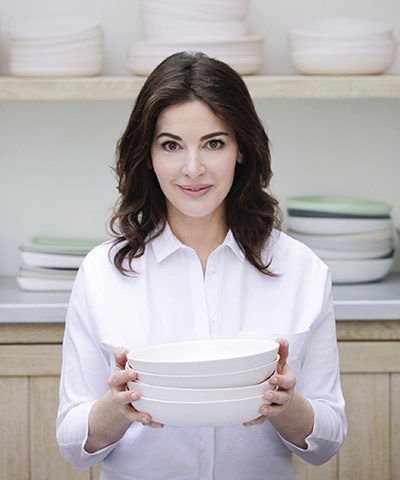


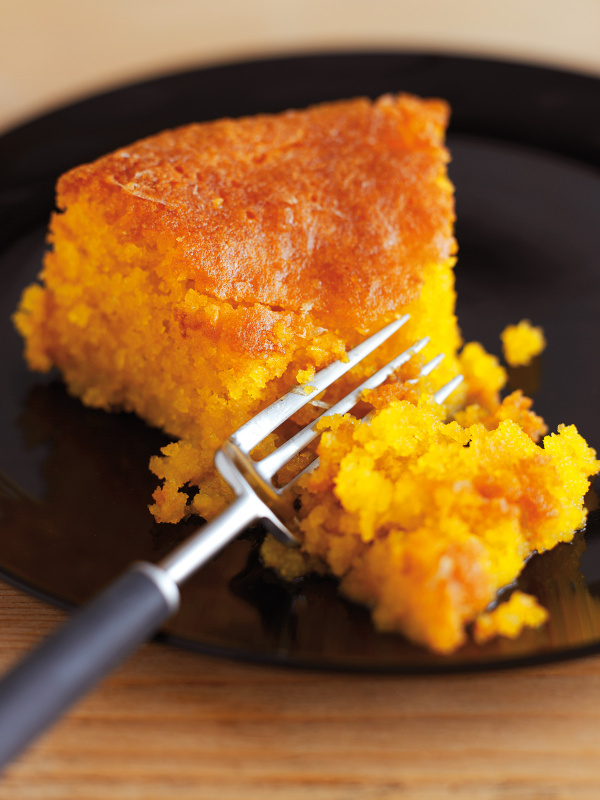
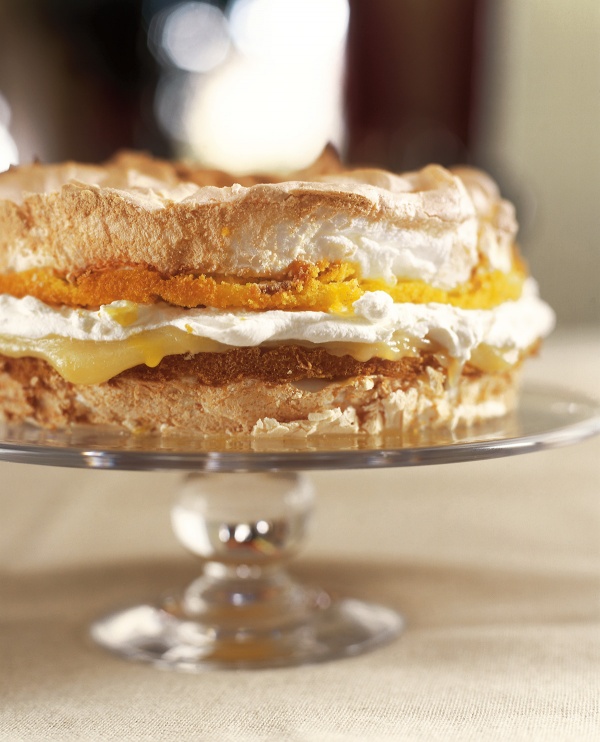
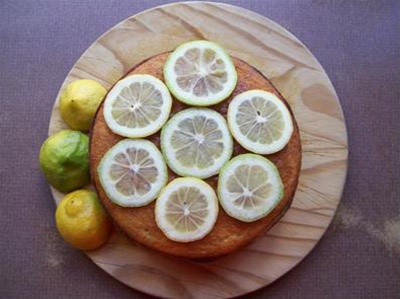
Tell us what you think
Thank you {% member.data['first-name'] %}.
Explore more recipesYour comment has been submitted.
What 1 Other has said
-
Posted by joshv41680 on 20th September 2022
Show more commentsI absolutely love the trio of Bundt cakes from “Simply Nigella”. This lemon and thyme version is especially good. The cake itself has a wonderful texture that is very moist and lush. The thyme is a brilliant partner with the lemon, and it puts an intriguing spin on the classic lemon cake idea. This particular cake is also a great all-rounder, and can be served at any time of the year. I’ve offered it as an option at summer barbecues as well as at Thanksgiving. It’s a winner!